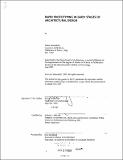Rapid prototyping in early stages of architectural design
Author(s)
Simondetti, Alvise
DownloadFull printable version (13.35Mb)
Other Contributors
Massachusetts Institute of Technology. Dept. of Architecture.
Advisor
William J. Mitchell.Recently with architects using it together with Rule-Based Design, Rapid Prototyping assumes the role of a tool for design thought in the sense that it speeds up the process of unlearning all the bad conventions of the first industrial revolution, the dark machine age, and throws light on both flexible and cellular manufacturing. The conclusions of my thesis are that change in design is inevitable; that it is difficult to realize the power of change of this technology before one uses it. Socrates skepticism about the value of the book suggests that evenwiser people misinterpret the implications of the "new" technology.
Terms of use
Metadata
Show full item recordAbstract
This thesis shows how architects can use Rapid Prototyping and what the advantages and disadvantages are in different manipulations of the tool. Chapter two attempts to chart a road map of the rapid prototyping media. The data were drawn from a number of first hand experiments conducted by the author as well as by colleagues in MIT School of Architecture and Harvard Graduate School of Design, and in actual practice. The whole research lies on the boundary between virtual and real, on physical prototyping from a digital file. Digital prototyping and manual prototyping are mentioned only as references. The research offers examples of manipulations of the media and conclude that rapid prototyping in preliminary stages of design is most appropriate when used in what is defined as Direct CAD (Computer Aided Design) with Direct CAM (Computer Aided Manufacturing). Furthermore, it identifies Semi -Direct CAD with Direct CAM as the manipulation most commonly used by architects. This manipulation is useful for presentation models but not very useful in early stages where ideas are less definite. This is the reason why rapid prototyping is generally considered inappropriate for early stages of architectural design. Instead of analyzing Rapid Prototyping technology this work concentrates on the process that involves Rapid Prototyping in new ways in design . It aims to stimulate the designer's imagination when thinking about three -dimensional design, design in motion and design at the interface between people and architecture, for example, chairs and kitchens. In this context Rapid Prototyping becomes merely a vehicle by which the architect explores the design process. Rapid Prototyping is proposed as a media to escape the limitation imposed by flat screen representation in what is defined as true three dimensional digital design. This technology was invented in engineering to increase design and manufacturing process performances.
Description
Thesis (M.S.)--Massachusetts Institute of Technology, Dept. of Architecture, 1997. Includes bibliographical references (leaves 59).
Date issued
1997Department
Massachusetts Institute of Technology. Department of ArchitecturePublisher
Massachusetts Institute of Technology
Keywords
Architecture.